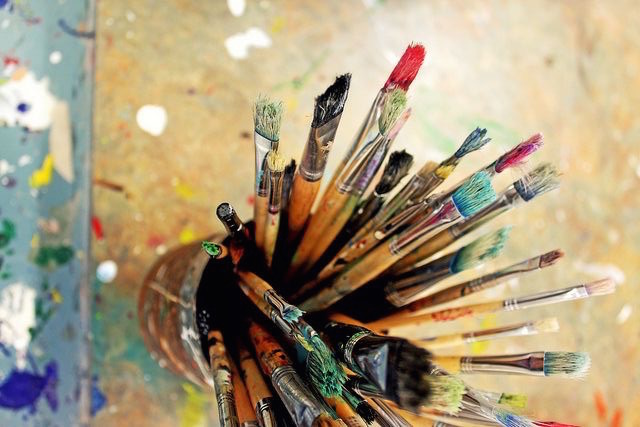
Navigating Complexity
Last week I reconnected to my strength. I was asked to present a one-hour workshop for 50 people at the Human Systems Dynamics Institute conference in Chicago: Navigating Complexity. I designed a process making a collaborative paining as a metaphor for the dynamics in complex adaptive systems. The whole process was in silence. I felt honored and humbled by the results that emerged. How was this so successful? And how was it so easy for me? I believe because I set conditions for self-organization and I shared for rules for creating a work of art together.
Setting conditions
I had created conditions for self-organization by laying out all the material in an attractive pattern on long tables: sheets of rice-paper, ink, water, paint, brushes. I explained the process in three clear steps. I heard afterwards that this clarity, my voice (!) and the music I played during the process, gave people the courage to trust their right-brain to take over and let judgment make place for curiosity.
Rules for making a painting
“So you think you can’t paint!” was the title of the workshop. To help people overcome their initial fear of painting I gave them some guiding principles.
1. Color doesn’t follow lines. We know this when we are five, but when we go to school, we are praised to stay within the lines. What excitable child will be motivated by that rule?
2. Two structures and a distinctive voice. This comes from Japanese Haiku’s and is generally true for our sense of balance. Think of two parents and a child. Or our Work-Life balance and the journey to/from work.
3. Layers create meaning. We pasted paper over our canvasses and painted over the paper. This makes for a high dimensionality. We like to dress in layers of clothing in matching colors and tell stories from multiple perspectives.
4. Less is more. We find it hard to restrain ourselves. We generally talk more than we listen, we eat more than we need, we use more paint than we should. The real challenge is: knowing when to stop.
Breaking away from self-imposed rules
With these guiding principles we made small canvasses and organized them into an infinite game of artistic collaboration: the group was able to break boundaries and continued to reinvent rules for artistic expression. Reflecting afterwards, people had witnessed a jolt of excitement at each new direction the group took. Breaking away from self-imposed rules that thwarted creative production; the same rules that end up making us think we can’t paint. What a waste!
Telling this story and getting this across in action, is what my strength is, I realized. I had almost forgotten. So, I went home invigorated and grateful for the opportunity to connect to the strength most needed in my life’s journey.
Do you want to learn more about using creative processes to leverage talent and create connectivity in groups, you might read up on action learning and the use of simple rules in complex adaptive systems. If you want to pursue this further, don’t hesitate to contact me.
Leave a Reply